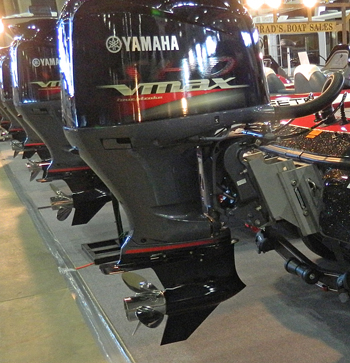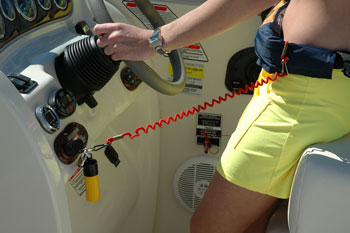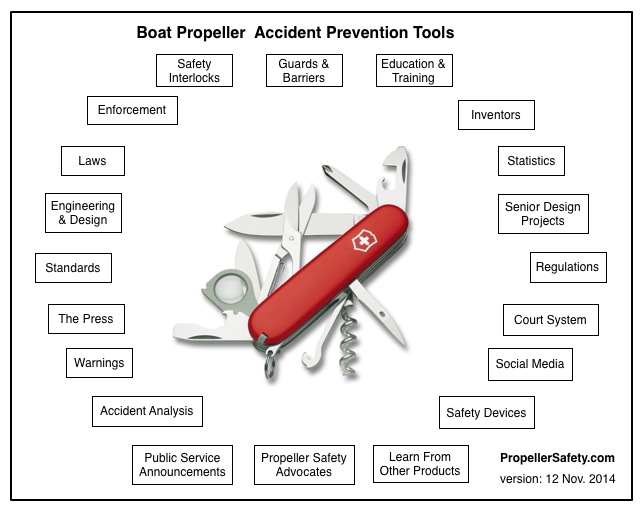Perpetual Boat Propeller Safety Hazards & How to Mitigate Them
Some Perpetual Boating Safety /Propeller Accident Scenarios
As a result of the issues described above, and more, we have been left with a number of PERPETUAL / ETERNAL boating safety / propeller safety accident scenarios including:
- Participants in towed sports being run over by the boat propeller after they fell from the skis/board/tube/inflatable and the operator returned to pick them up
- Unmanned outboard powered boats go in the Circle of Death
- Children bow ride pontoon boats underway, fall between the pontoons, and are struck by the propeller
- Operators reversing houseboats from beaches with swimmers in the water behind them
- Boat operator and others being ejected from a bass boat
- Bass boats strike submerged objects, their outboard motors break off, and flip into the vessel with their propeller still running
- Inflatable PFDs not inflating or being cut and deflated by propellers if they do
- Boaters not wearing their life jackets and if they do, they increase their likelihood of being entrapped on the propeller or being struck by the propeller in a Circle of Death accident
- Entrapped on open boat propellers
- Coaching, escort, and safety boats used with youth sailing, open water swimming, rowing, crewing, sculling, canoeing, wake surfing (with a sail), and other similar activities often in an amateur racing format are striking people in the water with their propellers. For example, the July 2017 Long Island New York accident
- Those reboarding the boat at the swim ladder are sucked into the propeller
- Divers and snorkelers being ran over by boat propellers and sometimes struck by the propeller of their own dive charter boat
- PWC riders interacting with the wake of boat or trying to spray those on board are stuck by the propeller
- Outboard motor starts in gear (typically involves rope started tiller steered outboards), one or more persons are ejected and struck by the propeller, can also happen with stern drives
- Someone jumped into the water unbeknownst to the operator OR just at the moment the operator was going to reverse the boat
A quick look at the list shows several of those accident scenarios are interrelated, and most of them are tied to issues listed below (People Hazards, Water Hazards, Industry Positions, Media Reluctance, Existing Boat Designs), and all go back to the basic principles of propellers (rotating and sharp).
How the Propeller Accident Scenarios Listed Above Became Perpetual
Boat propellers in conjunction with typical outboard motors present several basic hazards.
- They rotate at high speeds
- They are sharp
- Their location may not be obvious to all with the vessel
- Some people are not aware of the seriousness of the hazard rotating propellers present
- Propellers may be rotating when the operator and/or those in the water do not think they are
- They are typically not guarded
- They can suck people into them
- They can entrap people on them (hard to breath if wound up on a propeller with your head underwater)
When you combine this with the People Hazard
- They are in the water (they want to be in the water, it is part of the joy of boating and being at the lake)
- Use of alcohol
- Boater fatigue
- Rarely use life jackets or attach kill switch lanyards
- Not going to boating safety training courses
- Not keeping a lookout
- Not using spotters
And with the Hazards of Boating Activities
- Towed sports place people in proximity of the propeller
- Hustle of bass tournaments can result in poor decisions
- Party coves, large on water boat party events, can place people near rotating propellers
- On board party atmosphere combined with loud music and alcohol can lead to poor decisions, See Don’t Wreck Your Summer PSA below:
And with the Water Hazard
- Crowded waters
- Unmarked hazards (dredge pipes, floating logs, floating debris, stumps, etc.)
- Hard to find those injured on the water after the call went in even if they made it back to the boat
- Prolonged search and rescue operations
- Wakes and waves can eject those on board
And with the Media’s Reluctance to Cover Propeller Safety Issues
- Local media outlets in areas heavily dependent on recreational boating & fishing dollars are hesitant to cover boating accidents
- National boating magazines & their websites are heavily dependent upon boat and marine drive advertising dollars. Thus they are hesitant to cover boat accidents or propeller safety issues
- The U.S. Coast Guard is hesitant to create effective Public Service Announcements after the industry blocked, Don’t Wreck Your Summer
And with Boating Industry’s Position on Certain Issues
- Strongly oppose the use of propeller guards
- Not actively addressing perpetual problems
- Oppose regulation (as most industries do)
- Relying on voluntary standards organization (ABYC) (as most industries would like to be able to do)
- Do not want warnings all over their boats, makes boats look unsafe
- Failure to adopt / adapt ANSI Z535.4 warning standards long ago
- Warning design – warning design seems to be relegated to ABYC and NMMA for group consensus on primary warnings. Leaving secondary warnings (those not currently used on most vessels) to boat builders who sometimes lack the resources to complete the mission
- Blame boat operators and errors of others for causing boat accidents some of which could have been prevented by design
- Assume boat operators will read the warnings, read the operators manual, obey navigational rules, all on board will wear a life jacket, and the operator will attach the kill switch lanyard when at the same time, they know that is often not the case
- Rely on kill switches to prevent serious injuries and deaths in Circle of Death accidents when they know almost no one attaches the lanyard
- Fail to encourage many states to report boat accident data to the Coast Guard Public Boating Accident Report Database (BARD), as a result tens of thousands of reportable accidents are invisible to boating safety professionals
- Say they do not know what to do until standards exist for these new propeller safety products – its likely impossible to get ABYC to develop industry standards for a product the industry does not yet use
- Human Factors Analysis appears to be used to blame humans vs to design products less prone to human error
- Refusal to refer to kill switches as a “kill switch” has resulted in an array of phrases being used which complicates the message (attach your kill switch lanyard)
- Strongly resist all regulatory efforts. It is only natural for all industries to resist regulatory efforts. If they already wanted to do it (the change required by the regulation), they would be doing it, the government would not have to force them to do it.
And with the Challenges of Some Existing Boat Designs
- Low gunnels
- Swim ladders placed by propellers
- Log strike testing bass boat motors at half their top speed
- Outboard motors go into the Circle of Death when the operator is ejected
- The trend to ever larger, higher horsepower outboard motors continues, more horsepower results in faster vessels and larger diameter propellers, both bad for those in the water.
- Stainless steel propellers are frequently used on larger outboard motors. Stainless steel propellers are heavier (rotate with more energy) and sharper, increasing the probabilities of amputations and worse.
In light of these conditions, it is no wonder that some boating safety /propeller safety problems have become perpetual / eternal. It would be shocking if they had not.
Additional Reasons Why Some Propeller Safety Problems Remain Perpetual / Eternal
There are more reasons, some behind the scenes, why some propeller safety hazards have remained perpetual. For example, our 2012 piece on the possible suppression of some propeller safety technologies including propeller guards.
We previously identified some of these forces in our page on Agendas and Motivations of Major Players.
Mentioned briefly earlier, the industry sometimes chooses to rely on solutions they know will not be effective. For example, kill switch lanyards. The industry knows nobody wear them, but they want to play like they do, otherwise boats would be dangerous.Those new to propeller safety issues are typically slow to learn, that as with many industries, there is considerable resistance to change and new ideas.
Broad Methods to Address Perpetual / Eternal Boating Safety Issues
We identified several methods used to address boating accidents in our 2014 graphic below.
Examples of how these tools can be applied can be found in our post on Preventing Over the Bow Pontoon Boat Propeller Accidents.
Additional tools not specifically listed in the graphic above include:
- Outreach – Public Service Announcements (PSA), social media, training, education – The Coast Guard is currently “upping its game” in Outreach
- New Materials & Emerging Technologies – scientific breakthroughs trickle down to provide new tools for engineers and safety professionals. For example The Leash came from racing tire safety tethers used by NASCAR and others
- Public Policy – placing trauma centers in major boating area, inducements to life flight firms, build more helipads near lakes, etc.
Where We Fit In
With all these options and challenges on the table, Design and Engineering best fits our (PropellerSafety.com) skill set. Thus, as stated in our mission statement we focus on trying to more closely identify propeller safety issues, identify similar accidents with common causes, identify potential solutions, act as technology scout identifying new technologies with potential application to boat propeller safety issues, call attention to specific propeller accident scenarios and how they can or might be addressed, assist those developing solutions, and encourage the boating industry to take action on the proposed solutions or create their own.
This web site plus our Facebook page are tools developed to help further our mission.
How is the Industry Doing on Their Own?
To their credit, the industry has not been totally silent on the issue.
Propeller safety developments from marine drive firms over the last couple decades include:
- Mercury Marine’s Moving Propeller Alert
- Mercury has developed a new snap for their kill switch lanyard and a label associated with it that says “ATTACH LANYARD”.
- Engine overheat monitors are sometimes slowing Circle of Death vessels (water intake is reduced in a permanent banked turn)
- Many statements against the use of propeller guards
- Patent applications from Brunswick and Volvo Penta for systems or devices detecting people in the water. Our understanding is the Brunswick project is dead and no action has been observed from Volvo Penta on detecting people in the water since 2012. (UPDATE – a Brunswick patent application in this field was published by the U.S. Patent Office in November 2017)
- Brunswick/Mercury and Yamaha currently have employees or past executives or the U.S. Coast Guard National Boating Safety Advisory Council (NBSAC). Volvo Penta has had representation on the NBSAC in the past. Propeller safety issues are regularly discussed at NBSAC. However little, if anything ever makes it all the way to the water from NBSAC regarding propeller safety.
While the industry is not without action, they present no bold new solutions. Bold new solutions tend to come from aftermarket manufacturers.
Aftermarket boating safety / propeller safety innovations over the last couple decades include:
- Inflatable life jackets / PFDs increase wear rates
- MariTech’s swim ladder interlock switch
- MariTech (Virtual Lifeline / CAST), Autotether, and Fell Marine wireless lanyards
- Hot Foot foot throttles, while introduced long ago, have become wildly popular in bass boats. They have a positive side effect of slowing the vessel if the operator is ejected reducing Circle of Death propeller strikes when the operator fails to attach the kill switch lanyard.
- The Leash – a tether for bass boat outboard motors to prevent them from entering the vessel after striking submerged objects
- 3PO Navigator propeller guard with flip up rear shield to reduce drag
- We have seen some “Safety Propellers” none of which have yet made it to the marketplace
One propeller safety development fell on both sides (marine drive company AND the aftermarket).
In 2012, Yamaha introduced a propeller guard for small flood rescue outboards in the U.K., its success quickly grew and they made guards available for all Yamaha outboards. However, when we patted them on the back for going in the face of industry opposition to guards they quickly removed all online references to their propeller guard program. We later posted their statements from our archives. That guard is now available on the aftermarket as the Prop Deflector.
Historically we do not expect to see major advances in boat propeller safety come from within the industry (drive manufacturers). They tend to let others take the risks, then buy in when the time is right, like they did with kill switches back in the 1970s. That does not make them evil and is true of many industries. They are very risk adverse in terms of dedicating funds to developing new products outside of their existing product lines. But once one major player adopts a new safety device, the other players will likely jump on soon because they do not want to have to explain in court whey they were not using it when others were.
A Statement About Perpetual / Eternal Problems
Some say long standing design problems are not eternal and we agree with them.
Generich Allshuller, TRIZ expert, from his book “The Innovation Algorithm”
“The more eternal the problem, then usually the easier it is to solve. As a matter of fact, when the problem appears, the conditions to solve it already exist, Each unsuccessful attempt to solve it reduces the degree of uncertainty along with the search field.
Time passes by, and the degree of difficulty in solving the problem gets smaller – but the arsenal of technology continuously grows. This means that the relationship between these powers has changed. The problem becomes easier, while the means to solve it increases, becoming more powerful. Rarely are there problems in industry that are impossible to solve – even in the future.”
The common propeller injury scenarios identified in this post may not all be easily or totally solved, but practical, viable, economic solutions exist that will reduce propeller injuries, the seriousness of those injuries, and reduce fatalities from today’s levels.
The problem is to identify and deploy those solutions.
The Tools to Do The Work Are Shared in Part II
Part II of this post provides some tools and information for those trying to take propeller safety to the next level from a Design and Engineering standpoint, including pieces on the Safety Hierarchy, Hierarchy of Controls, Haddon’s 10 Countermeasures, Warnings and Warnings Beyond Labels.
Continue to Part II – the Safety Hierarchy


